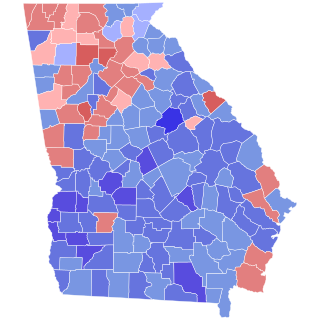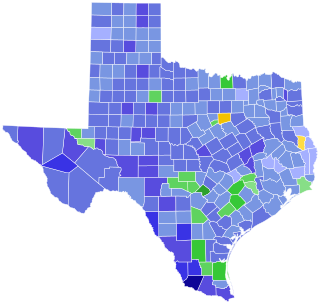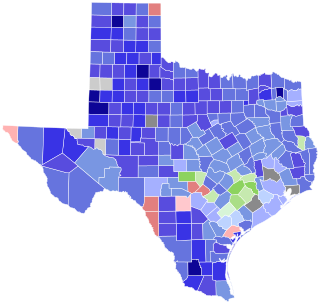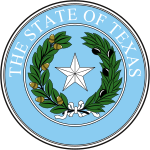
The 1978 United States Senate elections were held on November 7, in the middle of Democratic President Jimmy Carter's term. The 33 seats of Class 2 were contested in regular elections. Special elections were also held to fill vacancies.

The 1964 United States Senate elections were held on November 3. The 33 seats of Class 1 were contested in regular elections. Special elections were also held to fill vacancies. They coincided with the election of President Lyndon B. Johnson by an overwhelming majority, to a full term. His Democratic Party picked up a net two seats from the Republicans. As of 2023, this was the last time either party has had a two-thirds majority in the Senate, which allowed the Senate Democrats to override a veto, propose constitutional amendments, or convict and expel certain officials without any votes from Senate Republicans. However, internal divisions would have prevented the Democrats from having done so. The Senate election cycle coincided with Democratic gains in the House in the same year.

The 1952 United States Senate elections was an election for the United States Senate which coincided with the election of Dwight D. Eisenhower to the presidency by a large margin. The 32 Senate seats of Class 1 were contested in regular elections, and three special elections were held to fill vacancies. The Republicans took control of the Senate by managing to make a net gain of two seats. However, Wayne Morse (R-OR) became an independent forcing Republicans to rely on Vice President Richard Nixon's tie-breaking vote, although Republicans maintained a 48–47–1 plurality. Wayne Morse would caucus with the Republicans at the start of Congress’ second session on January 6, 1954 to allow the GOP to remain in control of the Senate. This was the third time, as well as second consecutive, in which a sitting Senate leader lost his seat.

The 1936 United States Senate elections coincided with the reelection of President Franklin D. Roosevelt. The 32 seats of Class 2 were contested in regular elections, and special elections were held to fill vacancies. The Great Depression continued and voters backed progressive candidates favoring Roosevelt's New Deal in races across the country. The Democrats gained 5 net seats during the election, and in combination with Democratic and Farmer–Labor interim appointments and the defection of George W. Norris from the Republican Party to become independent, the Republicans were reduced to 16 seats. Democrats gained a further two seats due to mid-term vacancies. The Democrats' 77 seats and their 62-seat majority remain their largest in history.

The 1998 Georgia gubernatorial election was held on November 3, 1998. Incumbent Democratic governor Zell Miller was unable to seek re-election due to term limits, therefore creating an open seat. To replace him, State Representative Roy Barnes won the Democratic Party's nomination after a close and highly contested primary election, while businessman Guy Millner, who had run for governor and the United States Senate in the previous four years, won the nomination of the Republican Party.

The 1934 United States Senate election in Texas was held on November 4, 1934. Incumbent Democratic U.S. Senator Tom Connally was re-elected to a second term. Connally fended off a competitive primary challenge from U.S. Representative Joseph Weldon Bailey Jr. on July 28 before facing only nominal opposition in the general election.

Randall Keith Weber is an American businessman and politician who has represented Texas's 14th congressional district in the United States House of Representatives since 2013. He was previously a member of the Texas House of Representatives, representing the 29th district. He is a member of the Republican Party.

The 1968 United States Senate election in New York was held on November 5, 1968. Incumbent Republican U.S. Senator Jacob Javits defeated Democratic challenger Paul O'Dwyer and Conservative Party challenger James Buckley in a three-way race.

The 1916 United States Senate election in Texas was held on November 7, 1916. Incumbent Democratic U.S. Senator Charles Culberson was re-elected to a fourth term in office. Culberson survived a challenge from former Governor Oscar Colquitt in the Democratic primary, then easily won the general election. He was challenged by Republican Alex W. Atcheson and Socialist Thomas Hickey, publisher of The Rebel.

The 1922 United States Senate election in Texas was held on November 7, 1922. Incumbent Democratic U.S. Senator Charles Culberson ran for re-election to a fifth term, but lost the Democratic primary. A runoff was held between former Governor Pa Ferguson and Railroads Commissioner Earle Bradford Mayfield.

The 1928 United States Senate election in Texas was held on November 6, 1928. Incumbent Democratic U.S. Senator Earle Mayfield ran for re-election to a second term.
Democrat William Proxmire won a special election to fill the vacancy created by the death of Senator Joseph R. McCarthy (R-WI). Also, Price Daniel (D-TX) left the Senate to become governor of Texas, and Democrat Ralph Yarborough won a special election for that Senate seat. The Democrats thus made a net gain of one seat. However, Congress was out of session at the time of the Democratic gain in Wisconsin, and the Republicans gained a Democratic-held seat only weeks after the next session started, when Republican John D. Hoblitzell Jr. was appointed to fill the vacancy created by the death of Senator Matthew M. Neely (D-WV).

The 1936 Texas gubernatorial election was held on November 3, 1936.

The 1934 Texas gubernatorial election was held on 6 November 1934 in order to elect the Governor of Texas. Democratic nominee and incumbent Attorney General of Texas James Burr V Allred defeated Republican nominee D. E. Waggoner in a landslide.

The 1932 Texas gubernatorial election was held on November 8, 1932, to elect the Governor of Texas. Democratic nominee and former Governor of Texas Miriam A. Ferguson defeated Republican nominee Orville Bullington.

The 1922 Texas gubernatorial election was held on 7 November 1922 in order to elect the Governor of Texas. Incumbent Democratic Governor Pat Morris Neff won re-election to a second term, defeating Republican candidate William Hawley Atwell in a landslide.

The 1920 Texas gubernatorial election was held on 2 November 1920 in order to elect the Governor of Texas. Former Democratic state representative Pat Morris Neff won comfortably in a four-way race against Republican nominee J. G. Culbertson, American Party of Texas nominee T. H. McGregor, and Black and Tan Republican nominee Hickerson Capers.

The 1918 Texas gubernatorial election was held on November 5, 1918, in order to elect the Governor of Texas. Incumbent Democratic governor William Pettus Hobby easily won re-election to his first full term after ascending to the governorship in 1917 upon the impeachment and conviction of his predecessor, governor James "Pa" Ferguson. He defeated Republican nominee Charles Albert Boynton.

The 1916 Texas gubernatorial election was held on November 7, 1916, in order to elect the Governor of Texas. Incumbent Democratic governor James E. "Pa" Ferguson easily won re-election to a second term, defeating his Republican challenger, Rentfro Creager.

The 1910 Texas gubernatorial election was held on November 8, 1910, in order to elect the Governor of Texas. Democrat Oscar Branch Colquitt, a member of the Texas Railroad Commission, won re-election to his first term as Governor of Texas.






















